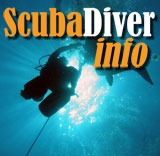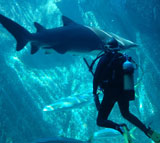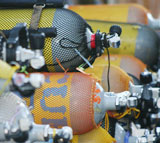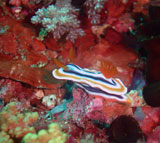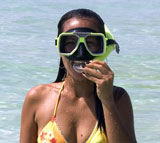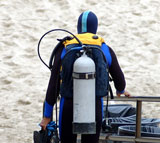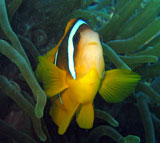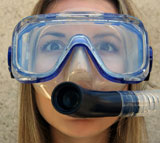Diving instruments
by Conrad H. Blickenstorfer
In this section we describe and discuss all the instruments necessary for scuba diving: submersible pressure gauge (SPG), depth gauge, timing device, as well as the optional ones such as compass and thermometer. We also describe dive computers, the marvelous devices that can fill the role of most instruments all in one package. (The instrument panel you see below is a UWATEC 2 Gauge Console containing an analog pressure gauge, a digital depth gauge and a small compass.)
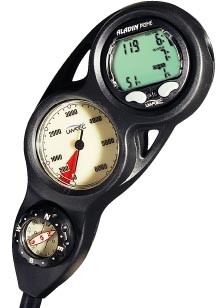
On the surface, the only instrument most people wear is a watch; you have to know what time it is. Underwater we need additional instruments to give us vital information. That information includes:
- The maximum depth reached
- The current depth
- The time spent underwater
- The current gas pressure in the cylinder
Why do we need to know all that? Maximum and current depth, and the time spent underwater, determines the amount of nitrogen your body has absorbed. Knowing time and depth also allows you to follow your dive plan and make sure you're not deviating from the Dive Table data that tells you how long you can stay under if you go down to a certain depth.
Knowing the gas pressure in the tank is also vital as it tells the diver how much air s/he has left. Air consumption, of course, varies with depth, but an experienced diver will be able to tell how many more minutes the air will last at a given depth.
There is other information that a diver needs an instrument for, though it is not as vital as depth, time, and air pressure:
- The direction you're going
- Current water temperature
A compass tells you where you are going, and that can be very important underwater where it is much easier to lose your orientation, especially in poor visibility. And a thermometer comes in handy to get alerted to changing temperatures that may lead to rapid heat loss.
Just like many other fields, the emergence of computers has revolutionized scuba diving as a dive computer can combine the functions of all of the above instruments, and then some. However, computers can malfunction or run out of power, and you should always have a backup pressure gauge, depth gauge and watch.
Finally, those instruments can be separate or combined into instrument consoles that contain two or more gauges. Some can be worn like watches and do, in fact, look and act like watches as well.
Pressure gauge
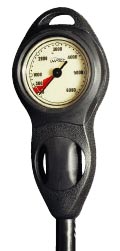 Submersible Pressure Gauges (SPGs) show, either in digital or analog form, the remaining pressure in the air tank. Most are connected to a high pressure outlet on the regulator's first stage via a high pressure hose. Some newer and more expensive ones don't have hoses, but receive air pressure information wirelessly via a transmitter integrated into the first stage. Pressure gauges can be mechanical or digital.
Submersible Pressure Gauges (SPGs) show, either in digital or analog form, the remaining pressure in the air tank. Most are connected to a high pressure outlet on the regulator's first stage via a high pressure hose. Some newer and more expensive ones don't have hoses, but receive air pressure information wirelessly via a transmitter integrated into the first stage. Pressure gauges can be mechanical or digital.
Mechanical ones generally use what is called a Bourdon tube--a circular or spiral oil-filled tube that is close on one end and has a diaphragm on the other. Air pressure pushes against the diaphragm, which pushes against the oil, which straightens the tube. The degree of straightening is then mechanically translated into a readout.
Digital SPGs use a transducer that converts pressure into voltage. The voltage is then converted into a digital signal that drives a digital readout.
Since most SPGs are connected via hose to the first stage by the tank, the SPG often is the "anchor" of an instrument console. The gauge shown above is a UWATEC Mini Pressure Gauge with an analog readout. It can optionally be equipped with a compass.
Depth gauge
Depth gauges work similar to pressure gauges and are based on the same technologies. There are digital onces with transducers, and mechanical ones that use a Bourdon tube or a diaphragm. There are also capillary gauges, but they are not very accurate and can only be used in waters less than 40 feet. Mechanical depth gauges have a secondary hand/pointer that moves along with the depth indicator as you go deeper. When you start ascent, the secondary pointer remains at maximum depth so that you have a record of it.
Timing devices
Underwater timing devices are just watches, but special ones. First, they obviously need to be waterproof. Note that the quoted water resistance on a watch does not include the extra pressure generated by moving around, so the "100 feet resistance" stamped onto a cheap digital watch may actually be much less. Go for one that is rated at least 300 feet. Conventional watch bands are not made to last long underwater; special plastic/rubber bands or woven nylon straps are best.
Analog diving watches must have a bezel that rotates counterclockwise only. That's so you can align the bezel
with the watch's minute hand and then see how long you've been under. Digital watches should have large digital readouts, a strong backlight, and buttons large enough to be easily operated even with diving gloves.
Compass
An underwater compass works just like a regular one, except that it must be waterproof.
Select one that is oil-filled to dampen the movements of the needlle, and has a rotating bezel. The compass has a lubber line that marks fore and aft.
Thermometer
It's not necessary to have a thermometer, but it's good to know what the water temperature is in order to properly dress and plan ahead. Thermometers may be separate instruments, but more often they are built into one of the other instruments, such as the watch or SPG.
Dive computer
Dive computers have revolutionized diving by making information available that simply wasn't available during a dive before. That's because a computer can sense and process a wealth of information continuously and display it for the diver. A computer can also warn a diver of dangerous situations.
Dive computers come in many shapes, sizes, forms and prices. Most look like digital watches that display some extra information. There are basic dive computers and very advanced ones with numerous features. However, all do one very important thing: they use depth and time information to keep track of nitrogen dissolved into the diver's body via a mathematical model and display how much time you have remaining. Dive tables do the same thing, but since computers continually monitor depth and surface intervals, which means the computer will usually give you extra bottomtime.
Your average dive computer will show you current depth, time underwater, remaining bottom time, as well as, depending on the model, percent oxygen of the air in your tank, water temperature, and if the computer is air-integrated, also remaining air pressure and based on that, remaining air time. Dive computers may display a lot more information than that, and most also have audible alarms to alert the diver to situations.
Overall, here are some of the functions a dive computer has, or may have:
- Full watch functions
- No-decompression time
- Depth
- Temperature
- Hoseless operation
- Air pressure (start/current/end)
- Low air pressure warning
- Altitude compensation
- Nitrox compatibility (for various mixes)
- PC or PDA interface (usually via infrared)
- Companion PC software
- Automatic freshwater/seawater adjustment
- Work rate compensation
- Over-exertion warning
- Adjustable "conservatism"
- Time to flying an aircraft
- Rapid Ascent speed warning
- Air time remaining
- Required safety stops
- Decompression time required (if any)
- Depths and times for subsequent dives
- Required surface interval
- Profile storage
- Integrated logbook(s)
- Various warnings
- Oxygen toxicity warning
- Automatic temperature compensation
Needless to say, with all that information available, it can be a bit confusing to figure out all the functions of a dive computer. 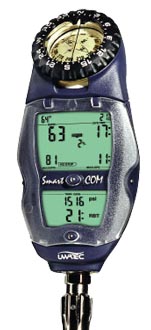 Fortunately, the important data is always clearly displayed and the major functions easy to use. Keep in mind, though, that dive computers may run out of battery power, that sensors can malfunction, and that all dive computers use certain proprietary mathematical models and algorithms. In other words, they use both hard data (like time, pressure and temperature) and soft data (the assumptions in the mathematical models).
Fortunately, the important data is always clearly displayed and the major functions easy to use. Keep in mind, though, that dive computers may run out of battery power, that sensors can malfunction, and that all dive computers use certain proprietary mathematical models and algorithms. In other words, they use both hard data (like time, pressure and temperature) and soft data (the assumptions in the mathematical models).
This means that while dive computers are totally terrific and have made diving simpler and safer, their data makes assumptions that may or may not be optimal. It also means that the all-important nitrogen absorption may be quite accurate for some peoples' bodies but not for others. Dive computers therefore include safety factors and are programmed fairly conservatively. One thing that is missing in most, if not all, are programmable body models that take into account size, weight, body fat and other physical characteristics of a diver. That is a serious oversight that should be addressed.
The diving computer shown to the right is UWATEC SmartCOM, an advanced console-style model that uses the traditional high pressure hose. The advantage of this type of computer is that the console style allows for large displays and large additional instruments, such as a compass.
Air-integrated computers
When we say a dive computer is air-integrated, it means that it can read the air pressure in the cylinder and use that information to not only display remaining pressure, but also remaining breathing time based on the current depth and air consumption rate.
Going wireless
Those who wish to cut down on the number of hoses may choose a dive computer with a wireless transmitter. The transmitter attaches to the first stage and communicates with the computer wirelessly via an encoded signal.
There are even top-of-the-line computers that can accommodate signals for multiple transmitters. This comes in handy for advanced technical divers who carry tanks with different gas mixtures and need to switch between them. And some wireless computers, such as the Scubapro SOL, can even display your dive buddy's air pressure if they wear compatible equipment.
While getting rid of a hose is certainly a (very) good thing, the wireless transmitter is fairly expensive (the transmitter alone can be over US$400), and it's something else that can go wrong. That said, we have never had a problem with a transmitter, batteries last very long (years), and they are easily replaced.
|
